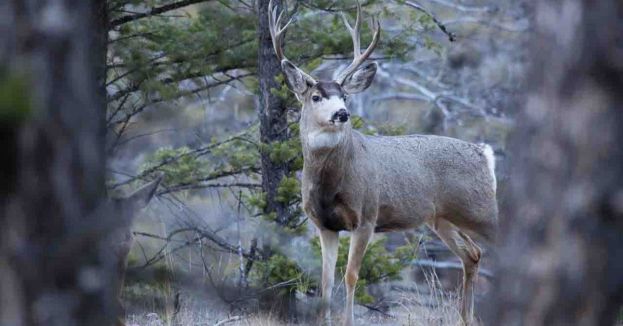A deer carcass found in the Wyoming section of the park tested positive for the highly infectious prion disease, according to the Centers for Disease Control and Prevention (CDC). The disease, which can cause weight loss, stumbling, lethargy, and neurological symptoms, has been identified in deer, elk, reindeer, and moose across North America, Canada, Norway, and South Korea.
The disease, which can take up to a year to manifest symptoms, has been colloquially dubbed the "zombie deer disease." This is due to the changes it induces in the brains and nervous systems of its hosts, causing animals to exhibit drooling, lethargy, emaciation, stumbling, and a characteristic "blank stare," as reported by The Guardian. The disease is invariably fatal, with no known treatments or vaccines currently available.
WATCH: NICOLE WALLACE AND THE END OF DEMOCRACY![]()
Scientists are now raising concerns about the possibility of the disease infecting humans, despite no recorded cases to date. Epidemiologists caution that the lack of a "spillover" case does not rule out the possibility of future occurrences. CWD is part of a group of fatal neurological disorders that includes Bovine spongiform encephalopathy (BSE), more commonly known as "mad cow disease."
YIKES! IS MARJORIE TAYLOR GREENE LOSING HER 'GRIP' IN POWER STRUGGLE?![]()
"The BSE outbreak in Britain provided an example of how, overnight, things can get crazy when a spillover event happens from, say, livestock to people," Dr. Cory Anderson, a program co-director at the Center for Infectious Disease Research and Policy (CIDRAP), told The Guardian.
WATCH: FETTERMAN CONFRONTED BY A PRO-HAMAS ACTIVIST![]()
December 24, 2023
"We’re talking about the potential of something similar occurring. No one is saying that it’s definitely going to happen, but it’s important for people to be prepared," Anderson added.
TESLA IN TURMOIL: MUSK OUSTS TOP EXECS AND PREPARES FOR MASSIVE LAYOFFS, WHAT'S HAPPENING?![]()
Another cause for concern is the lack of a known method to effectively and easily eradicate the disease, "neither from the animals it infects nor the environment it contaminates," Anderson said. Once an environment is infected, the pathogen is extremely difficult to eliminate. It can persist for years in soil or on surfaces, and is reportedly resistant to disinfectants, formaldehyde, radiation, and incineration at 1,100 F, according to The Guardian.
PROFESSIONAL "PROTEST CONSULTANT" CAUGHT ON VIDEO STIRRING UP CHAOS AT COLUMBIA UNIVERSITY![]()
The CDC, on its website, states that some animal studies suggest CWD poses a risk to certain types of non-human primates, such as monkeys, that consume meat from CWD-infected animals or come into contact with brain or body fluids from infected deer or elk.
PUMP AND DUMP: VIRAL "BOCA BASH" VIDEO SPARKS MAJOR INVESTIGATION![]()
"These studies raise concerns that there may also be a risk to people," the CDC website reads. "Since 1997, the World Health Organization has recommended that it is important to keep the agents of all known prion diseases from entering the human food chain."
DID KRISTI NOEM'S DISTURBING ACTIONS RUIN HER SHOT AT VP?![]()
Since the mid-1980s, the fatal brain disease has spread across Wyoming and is now found in most of the state, according to park officials. The disease is estimated to be present in 10-15% of the mule deer near Cody that migrate to the southeastern section of Yellowstone in the summer. The long-term impact of the disease on deer, elk, and moose in Yellowstone remains uncertain, Yellowstone National Park stated last month.
WTAF: BIDEN ADMINISTRATION IS 'SERIOUSLY CONSIDERING' TAKING IN REFUGEES FROM WHERE?![]()
The Alliance for Public Wildlife estimated in 2017 that between 7,000 and 15,000 CWD-infected animals are unknowingly consumed by humans each year, a figure expected to increase by 20% annually, according to The Guardian.
In 2005, researchers began observing 80 individuals who had inadvertently consumed infected meat. They found that the group had "no significant changes in health conditions," as reported by USA Today.
However, with hunting season in full swing, the CDC recommends hunters "strongly consider having those animals tested before eating the meat." The agency also advises hunters harvesting wild deer and elk from areas with reported CWD to check state wildlife and public health guidance to see whether testing of animals is recommended or required in a given state or region.
In response to the disease, Yellowstone staff have increased collaboration and information sharing with the Wyoming Game and Fish Department and other state agencies to identify areas within Yellowstone with increased risk for CWD.








 Discover alternative ideas that will make you think
Discover alternative ideas that will make you think Engage in mind bending debate
Engage in mind bending debate Earn points, rise in rank, have fun
Earn points, rise in rank, have fun


